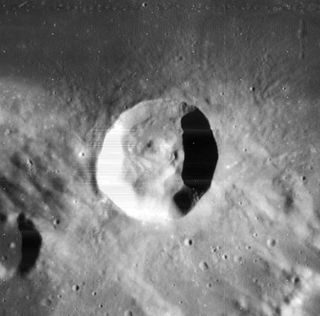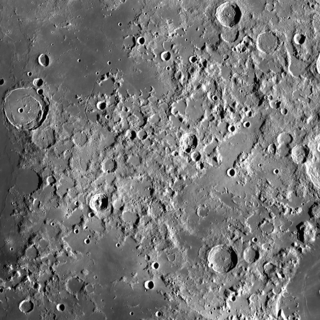
Mare Serenitatis is a lunar mare located to the east of Mare Imbrium on the Moon. Its diameter is 674 km (419 mi).

Mare Vaporum is a lunar mare located between the southwest rim of Mare Serenitatis and the southeast rim of Mare Imbrium. It was named by Giovanni Battista Riccioli in 1651.

Rille is typically used to describe any of the long, narrow depressions in the surface of the Moon that resemble channels. The Latin term is rima, plural rimae. Typically, a rille can be several kilometers wide and hundreds of kilometers in length. However, the term has also been used loosely to describe similar structures on a number of planets in the Solar System, including Mars, Venus, and on a number of moons. All bear a structural resemblance to each other.

Plinius is a prominent lunar impact crater on the border between Mare Serenitatis to the north and Mare Tranquilitatis to the south. Its diameter is 41 km. The crater is named after the Roman natural scientist and author Pliny the Elder. To the south-southeast of Plinius is the crater Ross, and to the northeast is Dawes. Just to the north is a system of rilles named the Rimae Plinius and touching it is the Brackett crater which is more than a crater diameter north. At the northwest edge of the rille is the Promontorium Archerusia, a cape off the western rim that encloses the Mare Serenitatis.

Menelaus is a young lunar impact crater located on the southern shore of Mare Serenitatis near the eastern end of the Montes Hæmus mountain range. Its diameter is 27 km. To the southwest is the small crater Auwers, and to the west-southwest is the even smaller Daubrée. To the northeast is a faint rille system named the Rimae Menelaus.

Brackett is a small lunar impact crater that lies near the southeast edge of Mare Serenitatis. The crater is named after American physicist Frederick Sumner Brackett. The crater has been covered by lava flow, leaving only a ring-shaped trace in the surrounding lunar mare. This crater is best observed under oblique illumination, as it is otherwise difficult to find. The southern rim is almost contacting a rille system named the Rimae Plinius.

Posidonius is a lunar impact crater that is located on the north-eastern edge of Mare Serenitatis, to the south of Lacus Somniorum. It was named after ancient Greek philosopher and geographer Posidonius of Apamea. The crater Chacornac is attached to the southeast rim, and to the north is Daniell.

Al-Bakri is a small lunar impact crater on the northwest edge of Mare Tranquillitatis. It is named after the Spanish Arab geographer and historian Abu Abdullah al-Bakri. It is just south of the eastern arm of the Montes Haemus that borders the Mare Serenitatis to the north. To the east-northeast is the prominent crater Plinius. South of the crater are the rilles of the Rimae Maclear.

Aratus is a small lunar impact crater located on the highland to the south and east of the rugged Montes Apenninus range. It is a circular, cup-shaped crater with a relatively high albedo. It was named after Greek astronomer Aratus of Soli. To the east is the Mare Serenitatis, and to the southwest is the somewhat larger crater Conon. North-northeast of Aratus is the landing site of the Apollo 15 mission, just beyond Mons Hadley Delta.

Sosigenes is a lunar impact crater on the west edge of Mare Tranquillitatis. Its diameter is 17 km. It was named after ancient Greek astronomer Sosigenes of Alexandria. It lies to the east of the large walled plain Julius Caesar. The crater rim has a high albedo, making it relatively bright. It has a small central rise at the midpoint of the floor.

Sulpicius Gallus is a small, bowl-shaped lunar impact crater that lies near the southwestern edge of the Mare Serenitatis. The crater is named after the 2nd century BC Roman astronomer Gaius Sulpicius Gallus.

Auwers is a small lunar impact crater located in the Montes Haemus mountain range at the south edge of Mare Serenitatis. It is named after German astronomer Arthur Auwers. It lies southeast of the crater Menelaus. The irregular rim of Auwers has a gap at the north-northwest edge, which allowed lava flows to reach the crater floor and flood the interior.

Calippus is a small lunar impact crater that is located on the eastern edge of the rugged Montes Caucasus mountain range in the northern part of the Moon. It was named after Greek astronomer Callippus of Cyzicus. It lies to the southwest of the crater remnant Alexander, to the northwest of the Mare Serenitatis.

Santos-Dumont is a small lunar impact crater that lies in the northern end of the Montes Apenninus range at the eastern edge of the Mare Imbrium. It is located about 30 kilometers to the northeast of Mons Hadley, a mountain massif.

Daubrée is a lunar impact crater that is located to the southwest of the Mare Serenitatis, just to the west-southwest of the crater Menelaus in the Montes Haemus range. The small lunar mare Lacus Hiemalis lies along the southwest rim of Daubrée. The crater was named after French geologist Gabriel A. Daubrée. It was previously designated Menelaus S.

Lacus Somniorum is a basaltic plain located in the northeastern part of the Moon's near side. It is located at selenographic coordinates 37.56° N, 30.8° E, and has a diameter of 424.76 kilometers. The name is Latin for Lake of Dreams, a title given to this feature by Giovanni Riccioli. It is the largest of the lunar features designated Lacus.

Lacus Felicitatis is a small patch of the lunar surface that has been inundated by flows of lava, leaving a level patch with a lower albedo than the surrounding ground. It is located in Terra Nivium, an area of continental ground to the north of the Mare Vaporum. About 70–80 km to the northeast of this area are the Montes Haemus, along the southwestern edge of the Mare Serenitatis.

Mons Bradley is a lunar mountain massif in the Montes Apenninus range, along the eastern edge of the Mare Imbrium. It is located to the west of the crater Conon. To the west of this peak is the Rima Bradley rille.

Montes Taurus is a rugged, jumbled mountainous region on the Moon. It is located to the east of the Mare Serenitatis, in the northeastern quadrant of the Moon's near side. Coordinates of their center are 27.32°N 40.34°E, and their extent is about 170 km.

Palus Putredinis is a small lunar mare in the basin of Mare Imbrium. It stretches from the crater Archimedes southeast toward the rugged Montes Apenninus range located on the southeastern edge of Mare Imbrium. This region is a nearly level, lava-flooded plain bounded by the crater Autolycus and nearby highlands to the northeast and the foothills of the Montes Archimedes to the southwest. The selenographic coordinates are 27.4° N, 0.0° E, and it lies within a diameter of 180 kilometers (110 mi).





















